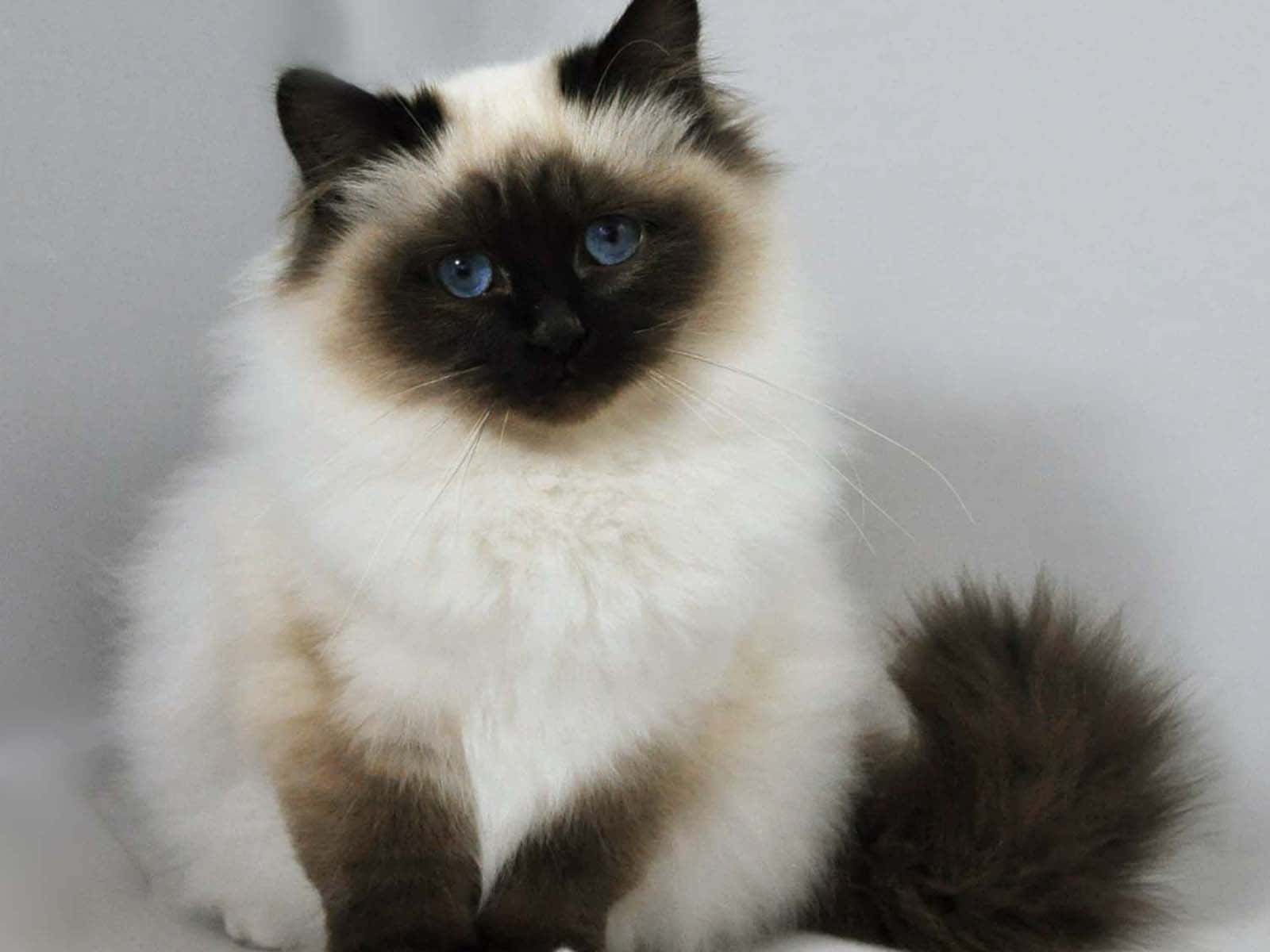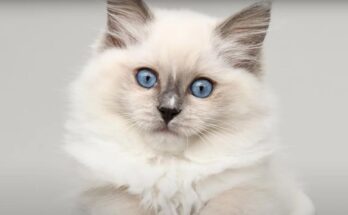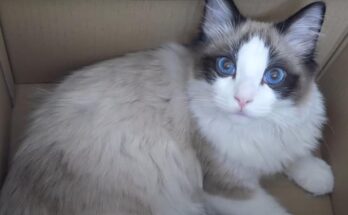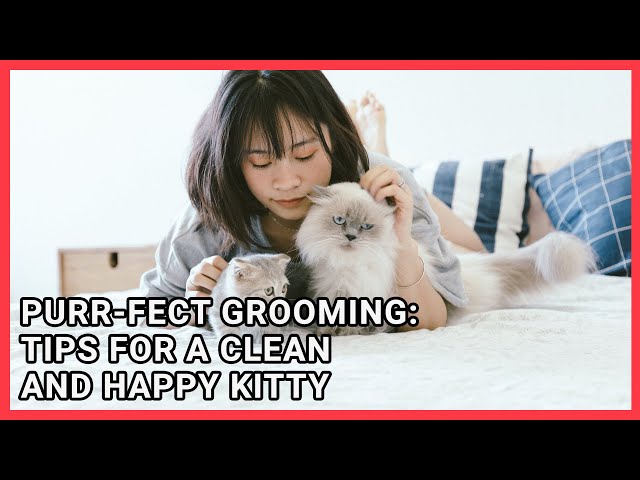Ragdoll tails are plush and long, typically featuring a bushy appearance. They complement the cat’s large, fluffy physique.
The Ragdoll breed is renowned for its striking blue eyes, semi-long fur, and gentle demeanour, making it a favored choice for families and pet lovers. These cats boast a characteristic color point coat, which means their body is lighter in color than their points: the ears, face, paws, and tail.
Their tail, in particular, adds to their distinctive elegance, often carried in a graceful arc that balances their sturdy build. These sociable and affectionate creatures often follow their owners around, earning them the nickname ‘puppy cats. ‘ The Ragdoll’s tail not only contributes to their overall beauty but also serves as an important tool for balance and communication, revealing much about their mood and intentions.
The Ragdoll Cat: An Introduction
Welcome to the whimsical world of Ragdoll cats, known for their striking blue eyes and gentle demeanor. Affectionate and friendly, these feline companions have captured hearts around the globe. Discover what makes the Ragdoll cat breed so unique and endearing.
Defining Characteristics
Ragdoll cats are easily identifiable by their:
- Large, sturdy frame
- Silky, semi-longhair coat
- Striking blue eyes
- Gentle and laid-back personality
Known to go limp when picked up, their docile nature and tendency to relax completely in the arms of their owners coined their unique name, “Ragdoll”.
Breed Origins And History
The Ragdoll breed began in the 1960s in California. Breeder Ann Baker is credited with developing the breed. Its ancestry includes breeds such as the Birman and Persian cats.
| Year | Milestone |
|---|---|
| 1960s | Origin of Ragdoll breed |
| 1970s | Recognition by major cat associations |
By 1970s, the breed gained recognition, strengthening its place in the hearts of cat lovers. Ragdolls continue to be popular for their friendly nature and beautiful appearance.

Credit: wallpapers.com
Tail Talk: More Than Just Fluff
When we gaze at a Ragdoll cat, we can’t help but admire their luxurious, bushy tails. But behind the soft appearance lies a tail that is both fascinating and enigmatic. Let’s unravel the mystery of the Ragdoll’s tail, piece by piece.
Anatomy Of The Ragdoll’s Tail
The Ragdoll’s tail is a marvel of feline anatomy. It is not just soft and fluffy but also incredibly flexible. A column of small bones, called vertebrae, runs through its entire length. These bones are cushioned by discs that allow smooth movement. Muscles and nerves weave through the tail, granting a Ragdoll control and sensation along its length. These features work together to ensure the tail’s health and functionality.
- Length: Ragdolls have long tails that often reach an impressive length of up to 11 inches.
- Fluffiness: Their tails are covered in plush, semi-long fur.
- Fur Texture: The fur is similar to rabbit’s, silky and requires regular grooming to avoid mats.
Functionality And Movement
The Ragdoll’s tail is not just for show. It serves critical functions in their daily lives. Balance is one of its primary roles, especially when navigating high places or making agile jumps. The tail acts like a counterweight to keep the Ragdoll steady. Communication is another key use, with the tail expressing emotions. A straight-up tail can signify happiness, while a tucked one may indicate fear. The tail’s flexibility is thanks to the synchronized work of muscles and vertebrae, allowing a wide range of movements.
| Movement | Function |
|---|---|
| High and Quivering | Greeting or excitement |
| Puffed | Fear or agitation |
| Wrapped around the body | Comfort or cold weather |
| Slow Movement from Side to Side | Deep concentration or hunting |
The Science Of Fluffiness
Those mesmerized by the plush tail of a Ragdoll cat know it’s not just fur. It’s a marvel of genetics and care. The fluffiness is not only a joy to touch but also a result of remarkable natural phenomena. Here, we explore the beautiful tail of a Ragdoll, its genetic roots, and the care it demands to stay splendid.
Genetics Behind The Tail Fur
The luxurious tail of a Ragdoll cat is a genetic gift. Each strand of fur comes from a tailored cocktail of parental genes. These genes determine the length, texture, and density of the tail fur. They also ensure the tail is perfectly plumed, complementing the cat’s striking physique.
| Gene | Function |
|---|---|
| Length Gene | Dictates fur length |
| Texture Gene | Sets fur’s softness |
| Density Gene | Controls volume of fur |
Maintenance And Grooming Needs
To keep the tail’s fluff in tip-top shape, a Ragdoll requires regular grooming. Neglect could lead to mats and tangles. Therefore, owners must invest time in proper grooming routines.
- Brush regularly to prevent mats.
- Use a wide-tooth comb for gentle detangling.
- Patience is key during grooming sessions.
- Specialized grooming tools may be helpful.
Proper care will keep the tail’s fur silky and mesmerizing. Additionally, this care will help to keep skin healthy and reduce shedding.
Mood Indicators: Decoding Tail Gestures
Welcome to our exploration of Ragdoll cat behavior, with a special focus on tail movements. Cats use their tails to communicate, and Ragdolls are no exception. By understanding their tail gestures, we can better understand their feelings and needs.
Emotional Expressions Through The Tail
The tail of a Ragdoll is a powerful tool for expressing emotions. A cat’s tail can reveal if they’re relaxed, scared, aggressive, or even curious. Let’s look at some tail gestures and what they mean for a Ragdoll’s mood.
Interpreting Common Tail Positions
Ragdoll cats have a variety of tail positions, each indicating a different mood or intention. Here’s a guide to decode these signals:
- Upright Tail: When a Ragdoll holds its tail high, it usually means they’re happy and confident.
- Tail Wrapped Around Their Body: This can imply a cat is seeking comfort or feeling unsure.
- Wagging or Twitching Tail: A Ragdoll might be irritated or excited if their tail is moving like this.
- Puffed-up Tail: This makes them look bigger and often means they are frightened or aggressive.
Recognizing these tail positions can strengthen the bond with your furry friend. Watch their tail, listen to their purr, and enjoy the silent language of Ragdolls.
Health And The Ragdoll Tail
Ragdoll cats charm families with their gentle temperaments and striking blue eyes. Their tails, long and fluffy, are iconic to their silhouette. Yet, like any other breed, these beautiful tails may face health issues. Knowing how to spot a problem is key to ensuring your Ragdoll’s tail stays healthy.
Common Tail-related Health Issues
Spotting unusual signs early helps keep your Ragdoll’s tail in perfect shape. Look out for these common tail-related health concerns:
- Limber Tail Syndrome: This can distress your Ragdoll, causing a limp tail.
- Fractures: These might result from accidental falls or impacts.
- Arthritis: Older Ragdolls may develop tail stiffness or pain.
- Over-grooming: It can indicate stress, leading to hair loss on the tail.
Preventative Care And Tips
Prevention is better than cure. Keep these tips in hand for a happy tail:
- Regular Vets Check-ups: Annual visits catch tail issues early.
- Gentle Handling: Educate kids on proper Ragdoll tail care.
- Active Lifestyle: Keep your Ragdoll moving to ward off tail arthritis.
Brush the tail gently but routinely. It removes knots and catches early signs of trouble. Provide a stress-free environment for your Ragdoll. It reduces over-grooming habits. Remember, a healthy tail is a sign of a happy and well-cared-for Ragdoll.
Breeding Secrets: Tail Traits
Ragdoll cats captivate hearts with their plush tails. Behind these luxurious tails lie fascinating breeding secrets. Tail traits matter, and breeders dedicate time to perfecting them. Let’s uncover the mysteries of Ragdoll tail characteristics.
Selective Breeding For Tail Quality
Breeders aim for the ideal tail length and fluffiness. Selective breeding plays a pivotal role. This involves choosing Ragdolls with desired tail traits for reproduction. The result? Offsprings with exquisite tails.
Tail health is also paramount. Healthy tails signify overall Ragdoll well-being. Breeders often pair Ragdolls based on tail robustness. This increases the likelihood of healthy tails in kittens.
- Length and fluffiness are focal points.
- Robust tails indicate good health.
- Breeding pairs are chosen for desired traits.
The Role Of Genetics In Tail Characteristics
Genetics are the blueprint for tail traits. They dictate length, plushness, and pattern. Ragdoll tails come from a complex genetic mix.
Tail characteristics can be dominant or recessive. Dominant traits appear more frequently in kittens. Recessive traits might hide for generations, only to appear unexpectedly.
| Trait | Genetic Type |
|---|---|
| Long Tail | Dominant |
| Plush Tail | Recessive |
Knowing genetic history helps breeders predict tail traits. DNA testing can guide breeders in their selection. Tail genetics create diversity and beauty in Ragdoll lineages.
Ragdoll Tails In Folklore And Culture
The Ragdoll cat, with its long, plush tail, has captured hearts worldwide. This breed’s distinct tail not only adds to their aesthetic appeal but also carries with it a trove of tales and presence in various cultures. People have crafted stories around the Ragdoll’s tail for centuries, echoing their enchanting personalities.
Myths Surrounding The Ragdoll’s Tail
Among the many peculiarities of the Ragdoll breed are the myths about their luxurious tails. Legends say that Ragdolls carry the souls of royalty, an idea that stems from their regal demeanor and elegant tails.
-
- Cats with certain tail shapes can cast spells, an old wives’ tale holds strong among some cat enthusiasts.
- Ragdoll tails are thought to bring good luck, which is why they are often depicted with raised tails in paintings and sculptures.
Ragdolls In Popular Culture
Ragdolls have leapt beyond folklore to take their place in pop culture. Distinctive features of this breed, including their tails, have become iconic.
| Film/TV Show | Ragdoll Feature |
|---|---|
| “The Cat Returns” | Animated royal cats with plumed tails |
| “Lil’ Bub & Friendz” | Tales of a Ragdoll’s inspiring journey |
Children’s books often introduce a Ragdoll character to teach about kindness, highlighting their tails as symbols of comfort and friendship.
Tails Of Remarkable Ragdolls
Welcome to the fluffy and affectionate world of Ragdoll cats! Known for their piercing blue eyes and silky coat, these charming felines boast one more distinctive feature – their expressive tails. In this section, we’ll explore the ‘Tails of Remarkable Ragdolls’, diving into the tales of famous Ragdolls and the heartwarming stories they create with their companions. Ragdoll tails, often bushy and plush, serve as the perfect symbol of their loving nature.
Famous Ragdoll Cats And Their Tails
Bold markings and lush textures set Ragdoll tails apart, helping these cats sweep the internet by storm. Let’s meet some famous feline celebrities:
- Merlin: Known for his extra-long tail that twitches in delight.
- Luna: A cat with a tail that curls perfectly around her when she sleeps.
- Oliver: His tail features a distinct color gradient, a true spectacle.
These famous Ragdolls’ tails contribute to their unique personalities and social media fame.
Heartwarming Tales Of Ragdoll Companions
Ragdoll cats form unbreakable bonds with their owners. These stories showcase their deep connection.
| Cat’s Name | Tail’s Tale |
|---|---|
| Zoey | She wraps her tail around her owner’s arm as a sign of love. |
| Max | His tail puffs up whenever he’s excited for playtime. |
| Bella | She flicks her tail high during her daily walks, showing off her pride and grace. |
Stories like these highlight how Ragdolls use their tails to express affection and joy.

Credit: m.youtube.com
Frequently Asked Questions On Ragdoll Tail
How Long Is A Ragdoll Cat’s Tail?
Ragdoll cats typically have long, fluffy tails that can measure between 9 to 11 inches. This proportionate length complements their large, muscular bodies.
Can A Ragdoll’s Tail Indicate Its Mood?
Yes, like most cats, Ragdolls use their tails to express emotions. A high, quivering tail signals happiness, while a tucked tail may indicate fear or submission.
Do Ragdoll Tails Require Special Grooming?
Ragdoll tails do need regular grooming due to their length and fluffiness. Brushing a few times per week prevents tangles and maintains the tail’s silky texture.
What Health Issues Affect Ragdoll Tails?
Ragdoll tails can be prone to matting and, in some cases, spinal problems like feline caudal vertebral malformation, which requires a vet’s attention.
Conclusion
Wrapping up our journey through the world of the Ragdoll tail, we’ve uncovered its charm and significance. From its fluffy grace to its communicative swishes, this feature enhances the breed’s allure. Remember, your Ragdoll’s tail requires gentle care. Cherish its unique beauty and expressive character as part of your furry companion’s endearing identity.



